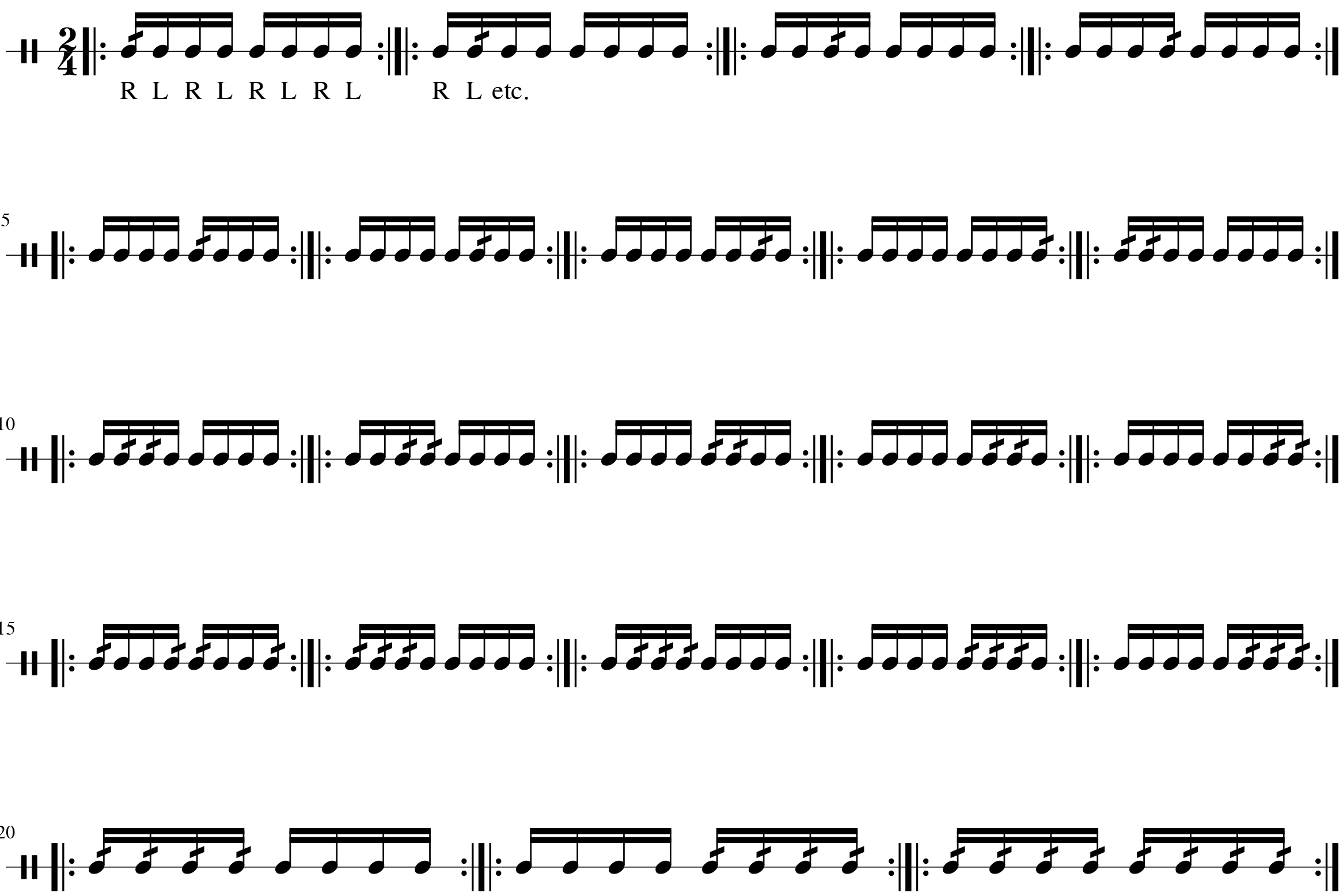In this lesson I’m going to go into more detail about mastering the double stroke roll. I’ll also give you some very specific exercises to practice, with detailed instructions.
To recap one of the things I mentioned in my other lesson, Mastering The Double Stroke Roll – Part 1, the first thing you need to be able to do to play a good double stroke roll is to be able to bounce the stick off the drum head or practice pad. So the first thing we’ll do is start with quarter notes.

Practice these quarter notes as half-strokes and full-strokes. They should also be practiced at lots of different dynamics. Practice medium loud. Practice soft.
When practicing double strokes as quarter notes, we’re actually getting 2 single strokes with each hand. This is important for developing control over the sticks and eventually the double stroke roll.
When practicing full and half strokes, start with a very loose grip. Make sure you can bounce the stick off the head before you start putting all your fingers around the stick.
As you start to work up your speed, and especially for practicing at medium and softer dynamics, put all your fingers around the stick. Learning to play double stroke rolls is a combination of letting the stick do a lot of the work and controlling the sticks. You can’t develop good control of the sticks until you have all your fingers on the stick.
Next we’ll practice double strokes as 8th notes.
Exercise 2: Double Strokes As 8th Notes
When practicing double strokes as 8th notes, you can stop practicing the full and half strokes, but continue practicing at a wide range of dynamics- one inch off the head, 3 inches, 6 inches, etc.
Again, keep all fingers around the sticks. Maintain a controlled, but completely relaxed grip. Don’t squeeze the sticks.
Gradually work up your speed using a metronome. Practice the exercise 20x or more at each speed before moving up the metronome.
Try to get the same sound every time you hit the drum. The second stroke should sound equally as loud as the first stroke. This will eventually result in a powerful, clean roll.
A quick note about accents: Several students have asked me if I accent the second double stroke in an effort to make sure it’s as strong as the first stroke. The answer is no. While I know that any accent practicing you do will give you more control of the sticks in general, I don’t feel that it’s a good way to learn to teach a student to do a double stroke roll. Eventually you want to get 2 bounces from the stick. Accenting the second stroke actually keeps you from getting the second bounce you’re after. Therefore I prefer to keep accents as a separate exercise altogether.
As you increase the speed and develop a feel for double strokes, you will find that you will start getting 2 bounces out of each stick, which is exactly what you want. In the beginning, and at slower tempos you will still be just doing 2 quick single strokes per stick which is fine. You are still at this point developing more control over the sticks.
The next exercise is to help you develop the ability to get a double stroke from the stick.
Exercise 3: Double Stroke Isolation Exercise
For this exercise, start with a loose grip. Bring the stick down and let it bounce twice. Then do the same with the the other hand. Start with the sticks high and practice loud. It’s easier to get a more natural bounce practicing loud in the beginning.
Gradually increase your speed. Eventually it will start to even out into 16th notes which is exactly what you want.
Here are double strokes written as 16th notes.
Exercise 4: Double Strokes As 16th Notes
The first way to practice these 16th notes is as described in the previous exercise. Start by practicing isolated double strokes and gradually increasing to even 16th notes. You can then gradually slow down again back to the broken, isolated double strokes. This is called practicing open to closed.
The second way of practicing is exactly the way you practiced the 8th notes. Practice with a metronome at all tempos and all dynamic levels. Again, at the slower tempos you’ll be actually doing two single strokes with each hand. But at faster tempos you will do a double stroke with each hand.
This takes a lot of experimenting to get the right feel. But eventually it becomes second nature.
Don’t be afraid to revert back to the completely loose grip, with some of the fingers off the stick sometimes in order to learn to get a double bounce out of the stick. But also spend some of your practice time with all fingers on the stick. That’s ultimately what you want, but sometimes it’s a gradual process. Many times when students put all their fingers on the stick they start to tighten up. So be very aware of tension in your hand. Let the stick do most of the work.
In the next exercise we’ll add 32nd note double strokes to groups of 16th notes. This will further develop your control over the double strokes as well as your speed.
Exercise 5: 8 Measure Double Stroke Diddle Exercise
Notice the sticking is just RLRL 16th notes. Every time you see a slash you play a double stroke instead of a single stroke. This is the way double strokes are usually written in drum corp music.
Practice these the same way. Start slow and gradually work up your speed. Practice at various dynamic levels.
The next exercise will help you develop the ability to place double strokes anywhere within a 16th note grouping. This again will develop more control over your double stroke roll.
Exercise 6: 2/4 Diddle Exercise
The same directions apply here. Start slow and work the exercise up with a metronome.
After you’ve mastered the exercise as written, practice it again while accenting each diddle stroke. Practicing accenting the diddles will give you even more control of your double stroke rolls.
In the next lesson I’ll cover double strokes as applied to triplet patterns.
